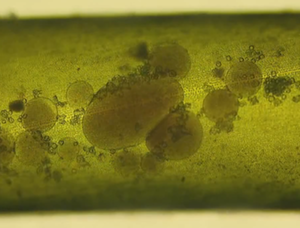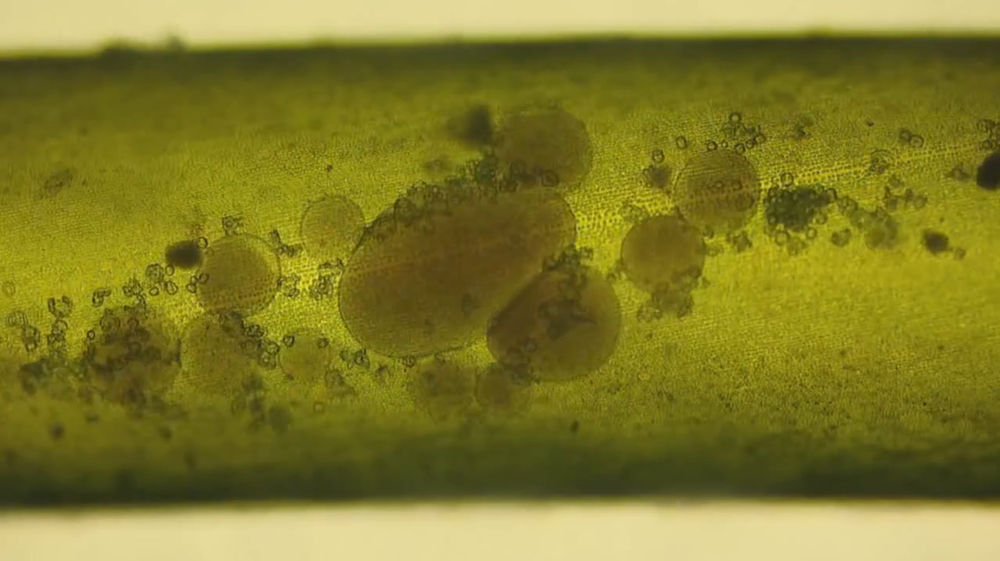How Cytoplasm Generates its Own Smooth Flow
Living cells can generate organized flow of their liquid cytoplasm, which may serve as an internal transportation system. A theoretical model described in Physical Review Letters explains how orderly, circulating flow in a droplet of cytoplasm taken from a cell can arise spontaneously from the uncoordinated fluid motion produced by single proteins moving along filamentary protein “tracks.” The model offers clues about the origin of a biological phenomenon that has remained mysterious for over two centuries and shows how a simple biological mechanism can produce order from randomness.
The orderly flow of fluid in cells, called cytoplasmic streaming, was first observed in living plant and algal cells in the eighteenth century. But it’s still not entirely clear what purpose it serves, says Ray Goldstein of the University of Cambridge in the UK. Since the 1950s, researchers have known that the fluid motion is driven by myosin motor proteins “walking” along strands of the fibrous polymer actin arranged on the inner surface of the cell membrane. A myosin molecule—pulling some larger molecular “cargo”—lands at random on a strand, walks toward one end, and then detaches again at random. The cargo entrains fluid as it is pulled along, causing the streaming flow.
Goldstein and Cambridge colleague Francis Woodhouse were intrigued by a 1953 experiment showing that vortexlike flow can emerge even when the cytoplasm is extracted from a cell as a drop of fluid encased in a membrane. In this case, the actin filaments float freely and are randomly oriented, because they are no longer attached to anything [1]. The walking proteins then produce no net force, but rather a “force dipole,” as the protein and cargo move in one direction and the filament in the other. The team wondered how these randomly-oriented filaments can become coordinated to produce orderly flow.
Woodhouse and Goldstein derived equations describing the flow induced by the dipolar forces of the walking proteins in a two-dimensional version of the experiment. They found that above a certain value of this “pushing” force, a disorderly flow state switches spontaneously to one that flows in a circulating manner. That prediction was confirmed when the two researchers solved the full equations by numerical simulations: above a threshold value of the force, a circulating flow appears, which organizes the filaments into interleaved spirals.
This self-organization arises because of interactions between the flows created by each protein/actin pair. Entrainment of fluid by a moving protein (and its cargo) tends to pull a nearby filament into alignment and coordinate its flow. It’s similar to the way neighboring bits of moving fluid can pull one another along to produce an orderly vortex as water runs down a drain.
Crucially, the circulation is stabilized because the whole system is confined by a circular boundary. In contrast, Goldstein explains that a mathematically identical but unbounded system “would display a decidedly unsteady, almost turbulent dynamics.”
The researchers say that their predicted transition from disorganized motion to circulating flow might be observed in experiments. Researchers could vary the activity of the motor proteins by controlling the concentration of ATP, the motors’ chemical fuel, or they could change the strength of the fluid interaction between myosin molecules by varying the cytoplasm’s viscosity.
The team also found that at high flow rates this simple circulation can evolve into more complex patterns, such as two separate centers for the rotational flow or flows in which the vortex center is offset and orbits the center of the circular boundary.
Other self-organizing systems include bacteria that “swarm” into a vortex pattern and fish that maintain alignment with their neighbors in a school. A common feature of such systems is the progression from simple to more complex patterns as the driving force increases [2]. But in most of these systems, the constituents are able to sense and respond to the orientation of those around them, rather than simply being pulled along by the fluid flow [3,4]. Woodhouse and Goldstein see their result as a demonstration of a new type of self-organizing system.
“What seems to be new here is that purely hydrodynamic interactions between active elements can give rise to swirling patterns,” says Herbert Levine of the University of California at San Diego. But he says it remains to be seen whether these ideas apply to cytoplasmic streaming inside living cells. Levine suspects that some cell types might have a more regulated way of creating large-scale stirring, if it is essential for their function.
–Philip Ball
Philip Ball is a freelance science writer in London. His latest book is How Life Works (Picador, 2024).
References
- Y. Yotsuyanagi, Recherches sur les Phénomènes moteurs dans les Fragments de Protoplasme isolés II. Mouvements divers déterminés par la condition de milieu,” Cytologia 18, 202 (1953)
- T. Vicsek and A. Zafeiris, “Collective Motion,” Phys. Rep. 517, 71 (2012)
- T. Vicsek, A. Czirók, E. Ben-Jacob, I. Cohen, and O. Shochet, “Novel Type of Phase Transition in a System of Self-Driven Particles,” Phys. Rev. Lett. 75, 1226 (1995)
- J. Toner and Y. Tu, “Flocks, Herds, and Schools: A Quantitative Theory of Flocking,” Phys. Rev. E 58, 4828 (1998)





